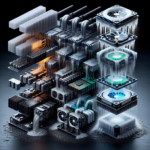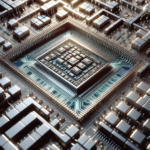The Evolution of CPU Cooling Technologies

The Evolution of CPU Cooling Technologies
As the heart of any computer system, the Central Processing Unit (CPU) is responsible for executing instructions and performing calculations. With the increasing demand for higher performance and efficiency, CPUs have become more powerful, generating significant amounts of heat. Effective cooling solutions are essential to maintain optimal performance and prevent overheating. This article delves into the evolution of CPU cooling technologies, exploring their development from basic methods to advanced systems.
Early CPU Cooling Methods
Passive Cooling
In the early days of computing, CPUs were relatively simple and did not generate much heat. Passive cooling methods, which rely on natural convection and radiation, were sufficient to dissipate the heat produced. These methods included:
- Heat Sinks: Metal fins attached to the CPU to increase surface area and facilitate heat dissipation.
- Thermal Paste: A compound applied between the CPU and heat sink to improve thermal conductivity.
Active Cooling
As CPUs became more powerful, passive cooling methods were no longer adequate. Active cooling solutions, which use additional components to enhance heat dissipation, were introduced. These included:
- Fans: Small fans mounted on heat sinks to increase airflow and improve cooling efficiency.
- Blowers: Devices that direct air through a specific path to cool the CPU more effectively.
Advancements in Air Cooling
Improved Heat Sink Designs
With the increasing heat output of modern CPUs, heat sink designs have evolved to enhance cooling performance. Innovations in this area include:
- Heat Pipes: Hollow tubes filled with a liquid that evaporates and condenses to transfer heat more efficiently.
- Tower Heat Sinks: Vertical heat sinks with multiple heat pipes and fins to maximize surface area and airflow.
- Direct Contact Heat Pipes: Heat pipes that make direct contact with the CPU surface for improved thermal transfer.
High-Performance Fans
Modern air cooling solutions also feature high-performance fans designed to provide better airflow and lower noise levels. These fans often include:
- PWM Control: Pulse-width modulation (PWM) technology allows for precise control of fan speed based on CPU temperature.
- Hydraulic Bearings: Advanced bearing designs that reduce friction and noise while increasing fan lifespan.
- Optimized Blade Designs: Fan blades engineered to maximize airflow and minimize turbulence.
Liquid Cooling Solutions
Closed-Loop Liquid Coolers (AIO)
All-in-One (AIO) liquid coolers have become popular due to their ease of installation and maintenance. These systems consist of a pump, radiator, and tubing pre-filled with coolant. Key features include:
- Compact Design: AIO coolers are designed to fit in most computer cases without requiring extensive modifications.
- Efficient Heat Transfer: Liquid coolant absorbs heat from the CPU and transfers it to the radiator, where it is dissipated by fans.
- Low Maintenance: AIO coolers are sealed systems that require minimal upkeep compared to custom liquid cooling loops.
Custom Liquid Cooling Loops
For enthusiasts seeking maximum cooling performance, custom liquid cooling loops offer unparalleled flexibility and efficiency. These systems allow users to design and build their own cooling loops using components such as:
- Pumps: High-performance pumps that circulate coolant through the system.
- Radiators: Large radiators with multiple fans to dissipate heat effectively.
- Reservoirs: Containers that hold extra coolant and facilitate air removal from the system.
- Water Blocks: Custom-designed blocks that make direct contact with the CPU and other components to transfer heat to the coolant.
Advanced Cooling Technologies
Phase Change Cooling
Phase change cooling systems use refrigerants to achieve extremely low temperatures, similar to those found in refrigeration units. These systems are capable of cooling CPUs to sub-zero temperatures, providing exceptional performance for overclocking enthusiasts. Key components include:
- Compressor: Compresses the refrigerant to increase its temperature and pressure.
- Condenser: Cools the compressed refrigerant, causing it to condense into a liquid.
- Evaporator: Absorbs heat from the CPU, causing the refrigerant to evaporate and cool the CPU.
Peltier (Thermoelectric) Cooling
Peltier cooling systems use thermoelectric modules to create a temperature differential between two surfaces. When an electric current passes through the module, one side becomes hot while the other side becomes cold. These systems can achieve very low temperatures but require careful management to prevent condensation. Key features include:
- Thermoelectric Modules: Devices that create a temperature differential when an electric current is applied.
- Heat Sinks and Fans: Used to dissipate heat from the hot side of the thermoelectric module.
- Insulation: Prevents condensation and protects components from moisture damage.
Emerging Cooling Technologies
Liquid Metal Cooling
Liquid metal cooling uses a liquid metal alloy, such as gallium or indium, to transfer heat away from the CPU. Liquid metal has a much higher thermal conductivity than traditional thermal pastes, providing superior cooling performance. However, it requires careful application and handling due to its conductive nature.
Immersion Cooling
Immersion cooling involves submerging computer components in a non-conductive liquid, such as mineral oil or specialized dielectric fluids. This method provides excellent heat dissipation and is particularly useful for high-density data centers. Key benefits include:
- Uniform Cooling: The entire surface of the components is cooled evenly.
- Reduced Noise: Eliminates the need for fans, resulting in quieter operation.
- Improved Efficiency: Enhanced cooling performance allows for higher component densities and reduced energy consumption.
FAQ
What is the primary purpose of CPU cooling?
The primary purpose of CPU cooling is to dissipate the heat generated by the CPU during operation. Effective cooling ensures that the CPU operates within safe temperature limits, preventing thermal throttling, maintaining performance, and extending the lifespan of the CPU and other components.
What are the main types of CPU cooling solutions?
The main types of CPU cooling solutions include air cooling, liquid cooling, phase change cooling, Peltier (thermoelectric) cooling, liquid metal cooling, and immersion cooling. Each type has its own advantages and disadvantages, depending on the specific requirements and preferences of the user.
How does liquid cooling compare to air cooling?
Liquid cooling generally provides better cooling performance than air cooling due to the higher thermal conductivity of liquids compared to air. Liquid cooling systems can dissipate heat more efficiently, allowing for lower CPU temperatures and potentially higher overclocking capabilities. However, liquid cooling systems are typically more complex, expensive, and require more maintenance than air cooling solutions.
What is the role of thermal paste in CPU cooling?
Thermal paste, also known as thermal compound or thermal grease, is applied between the CPU and the heat sink to improve thermal conductivity. It fills microscopic gaps and imperfections on the surfaces, ensuring better contact and more efficient heat transfer from the CPU to the heat sink.
Are there any risks associated with advanced cooling technologies?
Advanced cooling technologies, such as phase change cooling, Peltier cooling, and liquid metal cooling, can provide exceptional performance but also come with certain risks. These risks include condensation, electrical conductivity, and potential damage to components if not properly managed. Users should carefully research and follow best practices when implementing these cooling solutions to minimize risks.
Conclusion
The evolution of CPU cooling technologies has been driven by the increasing demands for higher performance and efficiency in modern computing. From early passive and active cooling methods to advanced liquid cooling systems and emerging technologies, the quest for optimal thermal management continues to push the boundaries of innovation. As CPUs become more powerful and generate more heat, effective cooling solutions will remain a critical component in ensuring the longevity and performance of computer systems.
Understanding the various cooling technologies available and their respective advantages and limitations can help users make informed decisions when selecting the best cooling solution for their needs. Whether it’s a high-performance gaming rig, a professional workstation, or a data center, the right cooling technology can make all the difference in achieving optimal performance and reliability.



